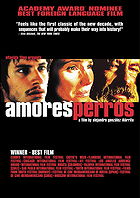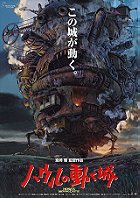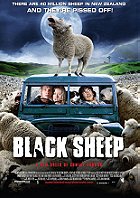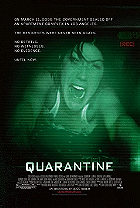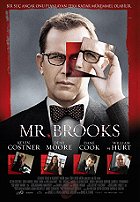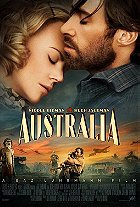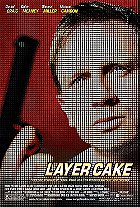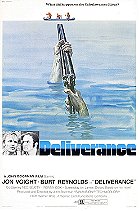On first impression, Vacancy probably seems like conventional, by-the-numbers horror fluff...upon closer inspection, this is anything but! In the midst of Hollywood's putrid "torture porn" movie craze (Hostel and its diabolical sequel are probably the worst offenders) it's indeed a rare occurrence to witness a good old-fashioned horror flick that relies on white-knuckle suspense as opposed to the senseless exploitation of gore and sex. Vacancy - the English-language debut feature of director Nimród Antal - isn't going to gain any awards for originality; as a matter of fact the premise and script are mediocre at best. However it's the filmic implementation that elevates this horror film high above the expected standard. Running at a scant 80 minutes, Vacancy is lean and mean. For the most part it hits the correct notes and provides a satisfying dosage of nail-biting tension. Director Antal competently creates a strong sense of atmosphere and escalating suspense. This is a very thrilling flick!
The story tracks David and Amy Fox (Wilson and Beckinsale, respectively) - they are a married couple in the middle of contemplating a divorce after their marriage is placed under substantial strain when they lose a child. While travelling home following a family function, their car breaks down on an isolated road. It's late at night, and the quarrelsome couple become compelled to hike in excess of a kilometre to a grungy little roadside motel (managed by a creepy fella played by Frank Whaley) which would make even the Bates Motel seem welcoming. It isn't long before David discovers a stash of snuff movies...eventually recognising that said movies had been filmed in their motel room. Trapped in their room with hidden cameras watching their every move, David and Amy realise they could become the stars of the sadistic filmmakers' next cult classic.
Vacancy is stripped down and raw. Once the nitty gritty commences there's scarce respite as it races along, offering moment after moment of genuine terror. All told, the film's runtime is a very tight 80 minutes. The film knows not to linger around for too long begging for attention - it starts, it gets to the point, and it humbly departs. Screenwriter Mark L. Smith admirably eschews a majority of the genre clichés. Vacancy offers just two protagonists as opposed to of a truck-load of disposable knife-fodder, therefore allowing a viewer to care far more about their fate. It takes its time establishing things, allowing us to familiarise ourselves with David and Amy. These are two moderately normal people...they aren't the dumb idiots that usually populate this kind of flick. Most commendably, there's no guarantee that either protagonist will survive to see the end credits. One of the film's strengths is in its frequent unpredictability - there's a strong sense that the protagonists may not make it out in one piece, let alone make it out at all.
Moreover, the main characters of this horror outing are smart. In the context of horror heroes, they are fairly intelligent. Compared to the people who were murdered prior to their stay, they're utter geniuses. They conduct themselves as reasonably intelligent adults might behave in a similar situation. David is also aware that he and Amy are no match for a group of killers in pitch black, especially in unknown surroundings. Therefore he doesn't engage them in hand-to-hand combat, nor does he attempt to set an ambush. Although the climax is somewhat predictable, Amy doesn't act like a superhuman nor does she mysteriously muster impressive martial arts skills in the blink of an eye. In fact, she even falls asleep at one stage - an act wholly human. Granted, a few times a bout of "here's what I'd do" will strike a viewer, and there are a few script mishaps, but the characters in Vacancy are still the smartest horror victims in recent memory. After a contemptible glut of horror films (ranging from Friday the 13th to Hostel, where the death of expendable supporting characters is perfunctory on account of it being fun to watch), Vacancy reminds us of what made Alfred Hitchcock's Psycho so remarkable: a handful of restricted sets and human characters.
Perhaps the most obvious thing that separates Vacancy from other contemporary horror films is in the content. Too often do horror films insert extra gore, sex and profanity for the sake of adding it as they're already bound for an R-rating from the MPAA. However, the film in question distinctively avoids displaying a vast majority of the violence - it usually happens off-screen. In addition, Vacancy avoids the inclusion of an obligatory sex scene. All of the sex and most of violence is on tape, witnessed with a bluish tint and flickering interference on a small TV screen. Frankly, this makes the violence and sex far less gratuitous and it's all the better for it.
Vacancy plays on ordinary human fears: loud noises late at night, a ringing phone with no-one at the opposite end, rats & roaches, claustrophobia, and a sense of hopeless isolation. Director Nimród Antal allows his cinematographer (veteran Andrzej Sekula) to intensify the impression of imminent doom. Each shot is meticulously composed to enhance the suspense. There are some truly masterful moments, perhaps the most ominous when David and Amy are harassed by noisy banging on the doors and walls. The normality of the situation is instantly shattered when mysterious noises erupt and panic begins to heighten. Antal builds the movie slowly, but even the build-up is reasonably creepy and chilling.
In spite of a number of flaws - and believe me, there are flaws - Vacancy gets more right than wrong. Still, it's far from perfect. The snarky dialogue between David and Amy is a waste of space. All the bickering seems redundant, even in the context of character development. The concept has also been exhaustively employed over the decades: a car breaks down in the middle of no-where, and bad things start to happen. Amy's cell phone also fails to get a signal in the middle of nowhere...how formulaic. Other flaws: sections of the story are difficult to accept, such as the main concept itself. It's doubtful the snuff film scheme could endure for so long. All the victims on tape appear to be stupid, defenceless, unintelligent horror victims. None of them attempt anything smart. Most detrimental is the conclusion. It's generic, and from a believability standpoint there are incalculable dilemmas. Had a clever rewrite courtesy of a skilled screenwriter transpired, Vacancy could have been this decade's king horror movie.
Luke Wilson and Kate Beckinsale manage their "every person" roles effectively. Wilson's handling of David succeeds, and his amiability seasons a bland role. Thank God none of the sleazy teenage idols of the early 21st century got this role. Beckinsale is also convincing as Amy. As fear pervades the tense atmosphere, the protagonists seem legitimately terrified. Never do these actors seem contrived; in fact their naturalistic performances aren't Hollywood at all.
Frank Whaley as the manager is sinister and sadistic. He'd make a good roommate for Norman Bates. Kudos to Whaley for placing forth a wholly believable and spine-chilling performance!
Perhaps expectations for Vacancy might have been quite low, but the product considerably outweighs any assumption of this being "just another silly horror film". From a creative point of view, Vacancy is leaps and bounds ahead of at least 80% of the current horror films from major studios. The script isn't particularly creative, but it's Antal's virtuoso direction that makes the film so effective. The movie is an accomplished brew of bright colours, dark shadows, and a grimy atmosphere. This is a terrific white-knuckle thriller - convincing performances mixed with a masterfully thrilling tone. If Psycho made people wary of showers, then the tense and tightly-paced Vacancy will make them think twice before stopping at a depressing old motel in the middle of nowhere - even if it's the only room available for hundreds of kilometres.
7.5/10
 Login
Login
 Home
Home 183 Lists
183 Lists 1670 Reviews
1670 Reviews Collections
Collections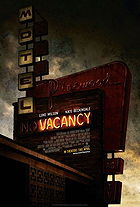
 0 comments,
0 comments, 